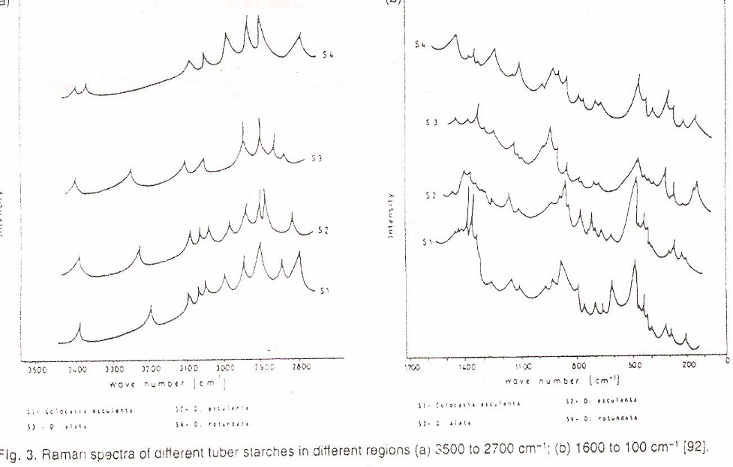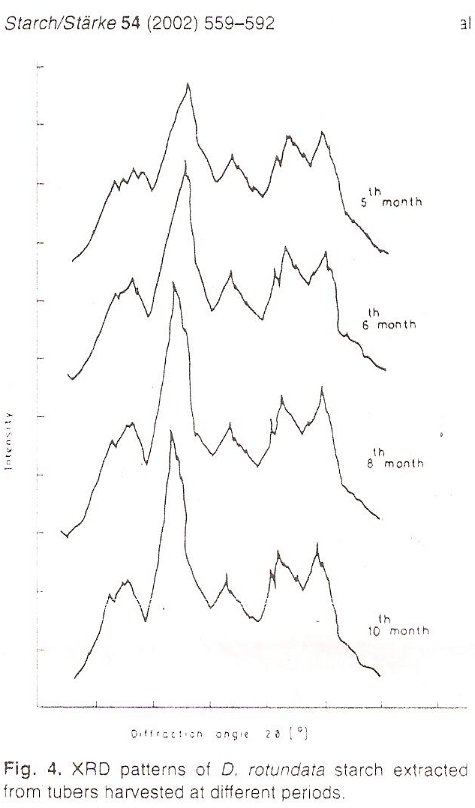Physicochemical and Functional Properties of Tropical Tuber Starches: A Review
Prev Page | Next Page- Introduction
- Extraction Techniques
- Other components in Starch
- Colour and Appearance
- Granule Shape and Size
- Spectral Features
- X-Ray Diffraction Pattern
- Molecular Weight
- Amylose Content
- Thermal Characteristics
- Gelatinisation and Pasting Temperatures
- Viscosity
- Swelling Power
- Solubility
- Clarity
- Sol stability
- Digestibility
- Conclusions
7. X-Ray Diffraction Pattern
Starch has a definite nature and the Crystallinity has been assigned to the well-ordered structure of the amylopectin molecules inside the granules. Different starches possess either ‘A’ , ‘B’ or ‘C’ pattern (which has been suggested to be a mixture of ‘A’ and ‘B’ patterns).
-
Cassava and Sweet Potato Starches
Cassava starch possesses ‘A’, ‘C’ or a mixed pattern with three major peaks at 2? = 15.3, 17.1 and 23.5o [33, 75, 89, 93-97]. The absolute Crystallinity values of starch from five varieties of cassava were found to be in the range 8-14% (Tab. 4) [41]. The flours of these five varieties also possessed similar XRD pattern and absolute Crystallinities. Earlier reports gave much higher values for the Crystallinity of cassava starch, viz. 38% [94] and the difference is attributed to the method used for calculation of the Crystallinity. Asaoka et al. [36] examined the diffraction pattern and absolute Crystallinity of some Colombian cassava varieties and found the values to be nearly the same during different seasons 915.3-17.3%0 and all possessing a ‘CA‘ pattern. Sriburi et al [98] reported that extrusion of the starch led to destruction of Crystallinity.
Figure 3

Figure 4

Figure 5

Sweet potato starch also was reported to possess ‘A’ pattern [25, 83, 89], ‘C’ [76, 94, 99, 100] or intermediate between ‘A’ and ‘C’ [23, 63, 101, 102]. Takeda et al. [25] observed ‘A’ pattern for two varieties while it was ‘CA’ for another variety. The absolute Crystallinity for this starch was 38% [94].
-
Other Starches
Colocasia, Xanthosoma, Pachyrrhizus, Arrowroot and Amorphophallus starches also possesses ‘A’ pattern [5, 86, 89] while edible Dioscorea starches (viz. D.alata, D.esculenta and d.rotundata), D. abysincia and D.cayensis starch possessed ‘B’ patterns. However ‘A’ pattern has been recorded for D.dumetorum starch [80], while McPherson and Jane [103] reported ‘C’ pattern of extracted starch is the same throughout the growth period of D. rotundata (Fig 5.). Starch of Canna edulis and Curcuma sp. exhibited ‘B’ pattern. The absolute Crystallinity of Canna starch was 26% [94]. A detatiled study of the XRD parameters of the starch extracted from Amorphophallus and Xanthosoma tuber subjected to pretreatment using different chemicals has been carried out. The ‘d’ spacing, angle intensity and peak intensity were found to be similar for control (water) and chemically pretreated samples of Amorphophallus samples. However, the peaks were shifted, indicating partial change in the crystalline phase [8, 9, 104]. For Xanthosoma starch, higher concentration brought about more significant changes especially with potassium metabsulphite pretreatment. It has been reported that the heat-moisture treatment of potato starch brings about change in the XRD pattern of potato starch from ‘B’ to ‘A’ [105], but such a change was not noticed with D. rotundata starch [106]. Lorenz and Kulp [107] also observed change in XRD patterns of cassava and arrow root starches by heat-moisture treatments.


